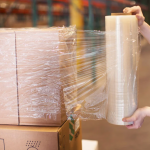
There are different types of stretch films that cater to different customer needs and application. So what is the best stretch film? The best stretch films are the ones that meet your goals, requirements and expectations.
Factors to consider are film gauge, pre-stretch capability, puncture resistance, tear propagation, etc.
The fact is, stretch film is one of the best inventions in industry application. But do you know how stretch films are made? In fact, knowing a little bit more about stretch films will help you choose the type of stretch films that are right for you, or the approach that you use to wrap your products.
The first thing you need to know is that there are two ways to make stretch films: cast and blown. Both have distinct advantages and disadvantages. There are also several traits that both types of films share, such as durability, which means how easily they tear compared to other types.
Film Extrusion
All stretch films begin with polymeric feed stock, which is often referred to ‘resin’. Some of the additives used in stretch films include:
- Pigment: for tinted or opaque films, mostly used for security reasons
- Tackifier: to provide cling so the film can stick to itself
- UV resistance: to prevent deterioration of film if they are stored outside
The extrusion process involves heating and compression of resin. Resin is first melted at the right temperature for the needed viscosity, before it’s being pushed through a die where the layer of plastic is created.
Blown Stretch Film
Blown stretch film is made by blown extrusion. The thermoplastic material is melted, emerges through a circular die, and a large bubble of air is blown inside. The volume of the bubble and the thickness of the extruded tube determine the thickness of the material.
It stands vertically and the bubble, which may be many feet tall, allows the film to cool gradually. Often in the wind process the edges are slit off and rolls are slit width and wound in line as the film is extruded. This is a vertical process.
The process is more complex than the one used to make cast stretch film, causing this type of wrap to become more expensive. Approximately 20-30% of stretch films manufactured today are blown.
Blown stretch films are more opaque due to the fact that it tends to crystallize during the process. By using this type of stretch film, the visibility of your products will reduce.
Cast Stretch Films
As the name of the films suggests, the process to produce is called cast extrusion. The first step requires the melting of thermoplastic material so it can go through a flat die. The melted resin goes onto a chill roll where the film becomes solid, similar to the cooling of plastic.
Sometimes the film is thinned to the target gauge by winding the resulting film faster than it is extruded. This is a horizontal process.
Cast stretch films make it easier to see through wrap, and the process is quieter. Cast stretch film can be used in pallet wrapping machines or you can also hand grade casts films.
Similarities
Now that you know how stretch films are made, you may be asking what’s the difference between these films. But let’s begin with the similarities between cast and blown stretch film:
- Both offer money saving pre stretch performance and effective load containment.
- Both handle a range of applications.
Now let’s look at the differences between them.
Differences
Blown Stretch film:
- Very resistant to puncture
- Higher levels of cling
- Make more noise unwinding
- Cloudy until stretch
- Bi directional tear resistance
- Excellent for C loads
Cast stretch films:
- Clearer and glossy
- Unwing quieter
- Resist Tear Propagation
- Great strength when using in pallet wrapping machines
- Forgiving Application
I’m sure now you have a better idea of which one to use.
Consider these before buying any type of stretch films: shape, type and weight of your load, environmental considerations, what sort of transport and storage your product will experience, and what pre stretch percentage you expect.
Remember stretch film will save you time and money, so look for the one that is best for you.





